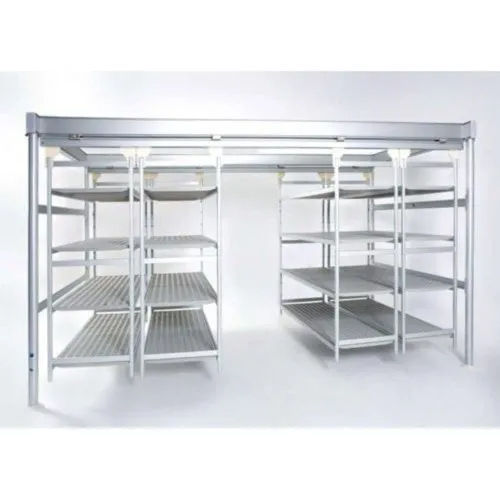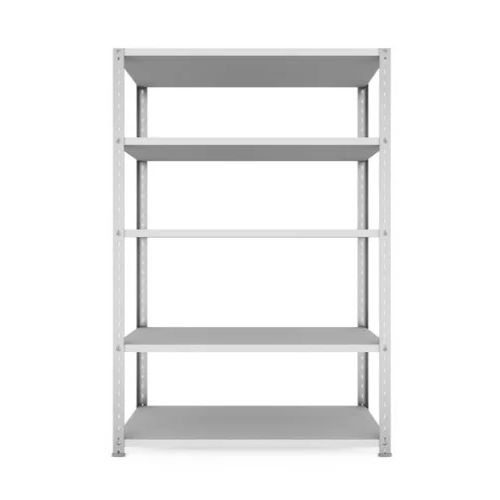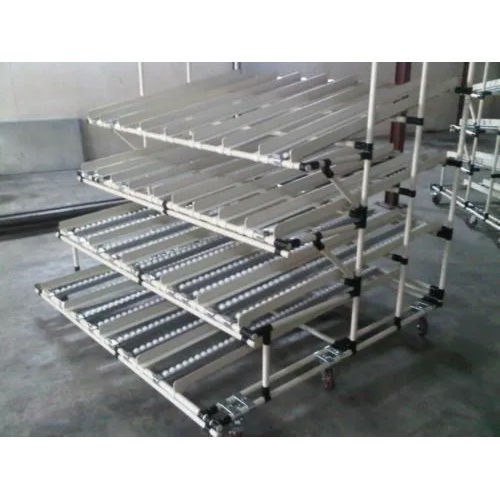Call us: 08045801720

Warehouse Stainless Steel Rack
2200 INR/Piece
Product Details:
- Usage Warehouse
- Color Silver
- Product Type Warehouse Stainless Steel Rack
- Height 5 Feet Foot (ft)
- Material Stainless Steel
- Click to view more
X
Warehouse Stainless Steel Rack Price And Quantity
- 100 Piece
- 2200 INR/Piece
Warehouse Stainless Steel Rack Product Specifications
- Warehouse Stainless Steel Rack
- 5 Feet Foot (ft)
- Warehouse
- Silver
- Stainless Steel
Warehouse Stainless Steel Rack Trade Information
- 1-7 Days
Product Description
A stainless steel rack for warehouse use is a sturdy and durable storage solution ideal for various industrial and commercial applications.
Here's a brief overview of what you might expect from a typical stainless steel rack designed for warehouse use:
1. Material: Stainless steel is chosen for its strength, durability, and resistance to corrosion, making it suitable for environments where cleanliness and hygiene are essential, such as warehouses storing food, pharmaceuticals, or chemicals.
2. Design: Stainless steel racks come in various designs, including boltless shelving, pallet racks, cantilever racks, and wire shelving systems. The design may vary based on the specific requirements of the warehouse, such as the types of goods being stored, available space, and handling equipment used.
3. Capacity: Stainless steel racks are designed to support heavy loads safely. The capacity of the rack will depend on factors such as the thickness of the steel, the design of the shelving, and the overall construction.
4. Adjustability: Many stainless steel racks offer adjustable shelves or configurations to accommodate different sizes and types of goods. This flexibility allows for efficient use of space and easy customization to meet changing storage needs.
5. Assembly: Depending on the design, stainless steel racks may require assembly upon delivery. Some racks feature a boltless design, making assembly quick and straightforward without the need for special tools.
6. Safety Features: Safety is paramount in warehouse environments. Stainless steel racks may incorporate features such as reinforced corners, sturdy construction, and load-bearing capacities to ensure the safety of both goods and personnel.
7. Maintenance: Stainless steel racks are relatively low maintenance, as stainless steel is resistant to rust and corrosion. Regular cleaning with mild detergents and water should suffice to keep the racks in good condition.
8. Cost: Stainless steel racks tend to be more expensive upfront compared to racks made from other materials. However, their longevity, durability, and resistance to corrosion can make them a cost-effective investment in the long run, especially in environments where cleanliness and hygiene are critical.
Warehouse Stainless Steel Rack Uses:
1. Food Storage: Stainless steel racks are ideal for storing food products in warehouses, cold storage facilities, and food processing plants. Stainless steel is non-corrosive and easy to clean, making it suitable for environments where cleanliness and hygiene are paramount.
2. Pharmaceutical Storage: Pharmaceuticals require storage in clean and hygienic environments to maintain their integrity and efficacy. Stainless steel racks provide a sterile storage solution, minimizing the risk of contamination and ensuring compliance with regulatory standards.
3. Chemical Storage: Stainless steel racks are resistant to corrosion from chemicals, making them suitable for storing hazardous materials and chemicals in warehouses and industrial facilities. They provide a safe and durable storage solution, minimizing the risk of spills or leaks.
4. Medical Supplies: Stainless steel racks are commonly used in healthcare facilities and medical warehouses to store medical supplies, equipment, and instruments. Their non-corrosive properties and ease of cleaning make them ideal for sterile storage environments.
5. Heavy-Duty Storage: Stainless steel racks are capable of supporting heavy loads, making them suitable for storing bulky or heavy items in warehouses and distribution centers. They provide a sturdy and durable storage solution, maximizing space efficiency and organization.
6. Cleanroom Storage: Cleanrooms require storage solutions that meet stringent cleanliness and contamination control standards. Stainless steel racks are ideal for cleanroom environments due to their non-porous surface, resistance to corrosion, and ease of cleaning.
7. Electronics Storage: Electronics components and equipment require protection from dust, moisture, and corrosion. Stainless steel racks provide a clean and dry storage environment, helping to prolong the lifespan of electronic devices and components.
8. Retail Inventory: Stainless steel racks can be used in retail warehouses and distribution centers to store inventory such as clothing, appliances, and consumer goods. Their adjustable shelving and sturdy construction make them suitable for organizing and displaying a wide range of products.
9. Wine and Beverage Storage: Stainless steel racks are commonly used in wineries, breweries, and beverage distribution centers to store bottles and barrels. The non-corrosive properties of stainless steel help preserve the quality of the beverages stored, ensuring they remain safe for consumption.
10. Archive and Document Storage: Stainless steel racks can be used to store archival documents, records, and files in warehouses and storage facilities. Their durable construction and corrosion-resistant properties help protect important documents from damage and deterioration over time.
Warehouse Stainless Steel Rack FAQ:
Q. What are the benefits of using stainless steel racks in warehouses?
Ans: Stainless steel racks offer several benefits, including durability, resistance to corrosion, ease of cleaning, suitability for hygiene-sensitive environments, and high load-bearing capacity.
Q. Are stainless steel racks suitable for storing heavy items?
Ans: Yes, stainless steel racks are designed to support heavy loads. They are commonly used for storing bulky items, pallets, machinery parts, and other heavy goods in warehouses and industrial facilities.
Q. Can stainless steel racks be customized to fit specific storage needs?
Ans: Yes, many stainless steel rack manufacturers offer customization options to fit specific storage requirements. This may include adjusting the height, width, and depth of shelves, as well as adding additional features such as dividers, bins, or label holders.
Q. How do I clean and maintain stainless steel racks?
Ans: Stainless steel racks are easy to clean and maintain. Regular cleaning with mild detergent and water is usually sufficient to remove dirt, grease, and stains. Avoid using abrasive cleaners or tools that could scratch the surface of the stainless steel.
Q. Are stainless steel racks resistant to rust and corrosion?
Ans: Yes, one of the main advantages of stainless steel is its resistance to rust and corrosion. This makes stainless steel racks suitable for use in humid environments, cold storage facilities, and areas where exposure to moisture or chemicals is common.
Q. Are stainless steel racks suitable for food storage?
Ans: Yes, stainless steel racks are commonly used for storing food products in warehouses, cold storage facilities, and food processing plants. Stainless steel is non-reactive and easy to clean, making it ideal for maintaining food hygiene standards.
Q. What types of industries commonly use stainless steel racks in their warehouses?
Ans: Stainless steel racks are used in a wide range of industries, including food and beverage, pharmaceuticals, healthcare, electronics, automotive, manufacturing, and logistics.
Q. Are stainless steel racks expensive compared to racks made from other materials?
Ans: While stainless steel racks may have a higher upfront cost compared to racks made from other materials, they offer long-term durability and resistance to corrosion, which can result in cost savings over time due to reduced maintenance and replacement costs.
Q. Can stainless steel racks be easily assembled?
Ans: Many stainless steel racks feature a boltless design, making them easy to assemble without the need for specialized tools. However, assembly difficulty may vary depending on the specific design and manufacturer.
Q. What are the weight capacities of stainless steel racks?
Ans: Weight capacities can vary depending on the design and construction of the stainless steel rack. It's essential to check the manufacturer's specifications to ensure that the rack can safely support the intended load.
Tell us about your requirement

Price:
Quantity
Select Unit
- 50
- 100
- 200
- 250
- 500
- 1000+
Additional detail
Mobile number
Email

 English
English Spanish
Spanish French
French German
German Italian
Italian Chinese (Simplified)
Chinese (Simplified) Japanese
Japanese Korean
Korean Arabic
Arabic Portuguese
Portuguese





